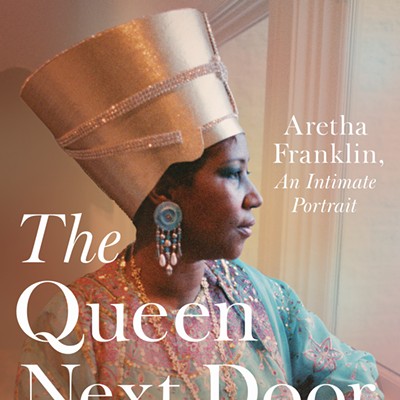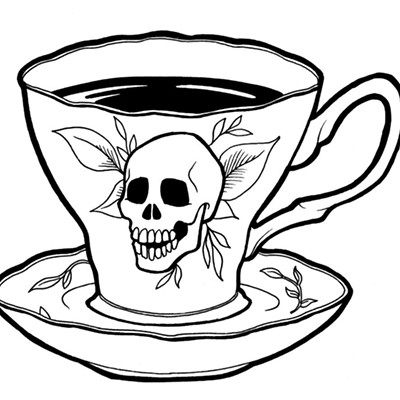In this particular year, nothing says Arizona as much as Gabrielle Giffords.
Tucson photographer A.T. Willett photographed the congresswoman on the night of the last election, Nov. 2, 2010, at a moment when she was not at all assured of victory. Yet in Willett's giant digital color photo, now on view at the Tucson Museum of Art, Giffords is her typical radiant self, standing confidently at a podium, flanked by supporters.
Willett retrospectively named the picture "Larger Than Life." For the viewer, looking at the image six months after Giffords and 18 others were shot, the photo seems to presage the violence that is to come. Amid the smiles of her fans and supporters, Giffords' husband, Mark Kelly, is somber-faced, even ashen. It's as though he's looking into the future.
Given the tragic events of January, "Larger Than Life"—sadly—is the most iconic Arizona image in the museum's big Arizona Biennial '11.
Every two years, the museum stages a juried exhibition of artists living and working in the state. This time around, the show was curated by an über-contemporary curator, Anne Ellegood, of UCLA's Hammer Museum. She winnowed 1,318 entries by 476 artists down to 73 pieces by 45 artists, selecting work that often manages to be both up-to-the-minute and evocative of Arizona.
Alan Bur Johnson, of Jerome, captures the delicacy of an Arizona post-monsoon moment in "Cadence," a 2010 photographic installation. He says he saw thousands of insect wings dropping out of the sky "in the glow of an August sunrise, spiraling gently to earth." He re-created this poetic apparition by making hundreds of photos of patterned insect wings. He printed the tiny images on transparent acetate, encased them in small round frames, and pinned them to the museum wall. They seem to be fluttering across its expanse. One can imagine the cascade of wings that Johnson saw.
Shannon Smith, of Tucson, photographed her young family with palpable emotion and in pungent color, placing them in Old Pueblo locations like El Tiradito and a Tucson backyard, where they dine alfresco. Her classic shots evoke all American families, all childhoods, merging the universal and the particular. The current moment she depicts in these pictures is already turning into memory.
Ellegood wisely selected expertly crafted works that, she says, demonstrate "strong technical skills" and "facility with materials." That doesn't mean the materials are always slick. Apart from some traditional oils and photographs, there's the usual array of contemporary items—soap, concrete, hemp fiber, copper piping, cardboard, cloth sacks, felt and shredded newspaper.
Christina You-Sun Park, of Tempe, used everyday corrugated cardboard to make a set of 3-D alphabet letters in her 2011 floor sculpture "Sentence Structure." Cardboard is about as humble as it gets, but Park cut it and assembled it as carefully as if she were working with precious wood. Her piece also succeeds metaphorically. The child of immigrant Korean parents, Park sees language as a barrier dividing the two generations, and her tumble of letters is a Tower of Babel.
Saskia Jorda, of Scottsdale, an immigrant from Venezuela, tackles Arizona's big issue of immigration elliptically and poetically—in white felt fabric. Her "Cartogram of Memory" is a lovely sculptural installation in two parts that uses the "vocabulary of mapping." (The project won her an Artist Project Grant from the Arizona Commission on the Arts last year.)
One large section dangles on wires from the ceiling; big holes have been cut into the fabric. The cut-out pieces have been saved and decorously piled atop each other on the floor—they look like a topographic map—creating a new immigrant's geography displaced from the old. The two sections are still attached, but loosely, via a white cord.
Born in 1988, Josh Schaffer, of Tucson, is perhaps the youngest artist in the show, and his materials are literally off the wall. He uses copper pipe and drywall in his brash and energetic "Study of an Aftermath," 2011. In time-honored rebel fashion, the young artist is literally breaking down the museum in order to get in. He's constructed a false wall and set it up along a gallery partition. The copper pipes are breaking through the drywall, and they've already scattered its pieces on the floor.
A. Brooke Heuts, of Phoenix, works with old-fashioned flour sacks and vintage quilts, stacking them in squares ("Little Woman," 2010) and sewing them into apron-like shapes that hang on the wall ("West 45 1/2 More or Less," 2011). The faded colors of these poignant works speak to the past and to the lives of those who left them behind.
Back in the category of more traditional materials, Dan Fogel, of Tempe, painted a pair of deliciously old-fashioned oils on canvas, and added cutting-edge irony by choosing an obsolete camera ("Polaroid," 2010) and a typewriter ("Royal," 2010) as his subjects. Setting them in undefined pictorial space, somehow he makes realism look new again.
Abstract painter Jeffrey Jonczyk, of Tucson, is as exuberant as ever. Too rarely seen nowadays in local galleries, he has three wonderful paintings here, all mixed media and acrylics, displayed one atop the other in a vertical burst of joy. A sweet street energy suffuses these layerings of jazzy color, messily brushed in and dripping paint. Flying saucers zip across "Calvacade"; circles and giant letters trip over rectangles in "Experiment."
Despite Jonczyk's cheery work, and the show's many other pleasures (David Adix's elegant collages, Lisa Robinson's serene photos of the sea), it's hard to shake the sadness of the haunting Giffords portrait that presides over everything else. Willett's photo has been inadvertently converted into a piece about joy's deceptions, and its fleetingness.
The picture turns our attention to the darker imagery in the rest of the show, works that seem to have sprung from an Age of Anxiety: Miles Conrad's large-scale installation (in soap!) about imprisonment and isolation, Denis Gillingwater's photo-cum-camera installation about government surveillance post-Sept. 11, Simon Donovan's harrowing video performance about domestic violence, Benjamin William Phillips' sculptural depiction of shattering old age.
Paradoxically, these disturbing works are all executed with a high degree of skill, even elegance. Conrad's "Recurrent Infraction"—seen earlier this season in a solo show at the Art Center Design College—is especially beautifully crafted. Within a side gallery, Conrad, proprietor of Conrad Wilde Gallery, has created a room designed for confinement—a jail cell, perhaps, or a ward in an old-time mental institution.
Every item, from the headboards of the two beds, to the interrogation chair, to the block walls that divide the room into ever-more-claustrophobic spaces, is covered by creamy soap. The soap, the artist says, refers to "sanitizing regimes," of the kind that attempt to wash out crimes, or demons, or sins.
One antidote to the ambient despair can be found in a hopeful painting by Tucson's Richard Zelens. His 2009 oil on canvas, "Everyday Saints ... Naked to the World," depicts two ordinary people in a deliberately naïve style. Naked as the title says, they stand in a hurricane of harrowing words, written in blood-red and black: hunger, rape, war, greed, sadness, war. But they don't succumb to the maelstrom.
Like the Everymen and Everywomen who came to the aid of the stricken and stopped the killer in his tracks on that terrible January day, these Everyday Saints try to stop the evil around them. They do what they can, when they can, trying to lead a virtuous life. And standing in a pool of golden light, they're sanctified by their own goodness and grace.













